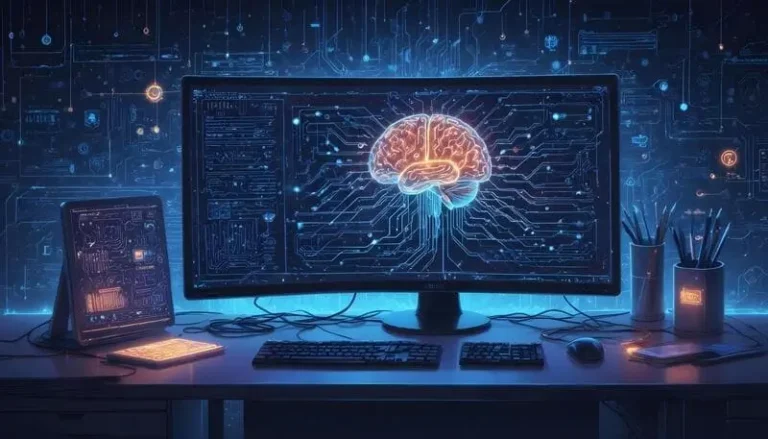Artificial Intelligence (AI) is everywhere these days—whether it’s powering voice assistants like Alexa, recommending shows on Netflix, or driving cars. But how does AI actually work? If you’ve ever wondered what’s behind the technology that makes machines “smart,” you’re not alone. The idea of machines thinking for themselves can feel a little mysterious, but it’s not as complicated as it might seem.
In this blog, we’ll break down how AI works in a way that’s easy to understand, even if you’re completely new to the concept. We’ll explore the basics of AI, how it learns, and some of the cool ways it’s being used in everyday life.
1. What Exactly Is Artificial Intelligence?
Let’s start with the basics. Artificial Intelligence (AI) is a type of technology that enables computers and machines to perform tasks that usually require human intelligence. This includes things like recognizing speech, solving problems, and making decisions.
Think of AI like the brainpower behind smart machines. It helps systems understand and process information, so they can carry out tasks on their own without needing constant instructions. In a way, AI is trying to teach machines how to “think” and “learn” from their experiences, much like humans do.
2. Machine Learning: The Core of AI
At the heart of most AI systems is something called machine learning (ML). This is a type of AI that allows computers to learn from data. Instead of simply following a set of rules, machine learning enables a computer to learn from examples and get better over time.
Here’s how it works:
- The machine is fed a lot of data (for example, pictures of cats and dogs).
- It processes the data and starts to recognize patterns (such as what features make a cat different from a dog).
- Over time, it learns to accurately identify cats and dogs without any help.
The more data the machine receives, the better it becomes at recognizing these patterns. This is why machine learning systems are constantly improving as they analyze more information.
3. AI Learns by Processing Data
AI systems need a lot of data to learn and improve. Think of data as the fuel that powers AI. For example, if you’re using an AI to predict the weather, the system will be fed huge amounts of past weather data, including temperatures, humidity, and wind patterns. The AI then uses this information to find patterns and make predictions about future weather.
The key to AI’s success is its ability to process and analyze massive amounts of data quickly—something that humans could never do on their own.
4. Types of Artificial Intelligence
AI comes in different flavors, depending on the complexity of the task it’s designed to perform. Here are two main types of AI:
Narrow AI
This is the most common type of AI we use today. Narrow AI is designed to perform a specific task. For example:
- Siri or Alexa: These virtual assistants can answer questions and perform actions based on voice commands.
- Netflix recommendations: AI analyzes what you’ve watched and suggests shows or movies you might like.
Narrow AI is super-focused and works within its predefined limits. It doesn’t “think” outside of the tasks it’s trained for.
General AI
This is the kind of AI you see in sci-fi movies, where machines can think and reason like humans across all areas. General AI doesn’t exist yet, but researchers are working on it. It would be able to perform any intellectual task a human can do—learning, reasoning, and adapting to new situations.
5. AI in Everyday Life
You might not realize it, but AI is already a part of your daily life. Here are a few examples of how AI helps make things easier and smarter:
- Voice Assistants: Tools like Siri, Alexa, and Google Assistant use AI to understand what you say and respond appropriately.
- Personalized Ads: Ever notice how the ads you see online seem to be exactly what you’re interested in? That’s AI at work, analyzing your browsing habits and tailoring ads specifically for you.
- Self-Driving Cars: Autonomous vehicles use AI to make decisions in real time, like when to turn or stop, by analyzing their surroundings.
- Healthcare:AI is helping doctors by analyzing medical data to assist in diagnosing diseases faster and more accurately.
6. Challenges and Limitations of AI
While AI is super impressive, it’s not perfect. There are still a few challenges:
- Bias: AI learns from data, and if the data it’s trained on is biased, it can make biased decisions. For example, if an AI system is trained on data that’s biased against certain groups of people, it might carry that bias forward in its predictions or decisions.
- Lack of Creativity: AI is great at following patterns, but it doesn’t think creatively or come up with new ideas like humans do. It excels at repetitive tasks but struggles with innovation.
- Dependence on Data: AI needs a ton of data to function well. Without good data, the AI can’t make accurate decisions.
7. The Future of AI
AI is still in its early stages, but it’s improving quickly. As AI systems get better at learning and understanding the world, they’ll be able to take on even more complex tasks. We might see AI helping doctors perform surgeries, designing smart cities, or even collaborating with humans to solve global challenges like climate change.
Final Thoughts: How Does AI Work?
In simple terms, AI works by using data and algorithms to learn, recognize patterns, and make decisions—without needing constant human supervision. Whether it’s recommending your next Netflix binge or helping doctors detect diseases early, AI is already transforming the world around us.
But it’s important to remember that AI is a tool. It doesn’t have human emotions, creativity, or intuition, but it does have the ability to enhance and support the work we do every day.
Curious to learn more about how AI could help you in your daily life or business? Reach out to us for a deeper dive into the exciting world of AI and how it’s shaping the future!





